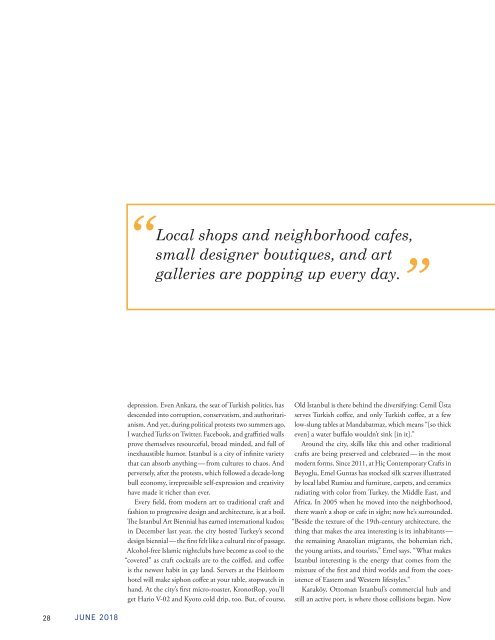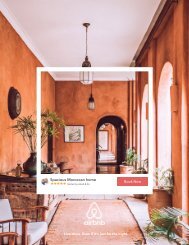En Route
You also want an ePaper? Increase the reach of your titles
YUMPU automatically turns print PDFs into web optimized ePapers that Google loves.
“<br />
Local shops and neighborhood cafes,<br />
small designer boutiques, and art<br />
galleries are popping up every day.<br />
”<br />
depression. Even Ankara, the seat of Turkish politics, has<br />
descended into corruption, conservatism, and authoritarianism.<br />
And yet, during political protests two summers ago,<br />
I watched Turks on Twitter, Facebook, and graffitied walls<br />
prove themselves resourceful, broad minded, and full of<br />
inexhaustible humor. Istanbul is a city of infinite variety<br />
that can absorb anything — from cultures to chaos. And<br />
perversely, after the protests, which followed a decade-long<br />
bull economy, irrepressible self-expression and creativity<br />
have made it richer than ever.<br />
Every field, from modern art to traditional craft and<br />
fashion to progressive design and architecture, is at a boil.<br />
The Istanbul Art Biennial has earned international kudos;<br />
in December last year, the city hosted Turkey’s second<br />
design biennial — the first felt like a cultural rite of passage.<br />
Alcohol-free Islamic nightclubs have become as cool to the<br />
“covered” as craft cocktails are to the coiffed, and coffee<br />
is the newest habit in çay land. Servers at the Heirloom<br />
hotel will make siphon coffee at your table, stopwatch in<br />
hand. At the city’s first micro-roaster, KronotRop, you’ll<br />
get Hario V-02 and Kyoto cold drip, too. But, of course,<br />
Old Istanbul is there behind the diversifying: Cemil Üsta<br />
serves Turkish coffee, and only Turkish coffee, at a few<br />
low-slung tables at Mandabatmaz, which means “[so thick<br />
even] a water buffalo wouldn’t sink [in it].”<br />
Around the city, skills like this and other traditional<br />
crafts are being preserved and celebrated — in the most<br />
modern forms. Since 2011, at Hiç Contemporary Crafts in<br />
Beyoglu, Emel Guntas has stocked silk scarves illustrated<br />
by local label Rumisu and furniture, carpets, and ceramics<br />
radiating with color from Turkey, the Middle East, and<br />
Africa. In 2005 when he moved into the neighborhood,<br />
there wasn’t a shop or cafe in sight; now he’s surrounded.<br />
“Beside the texture of the 19th-century architecture, the<br />
thing that makes the area interesting is its inhabitants —<br />
the remaining Anatolian migrants, the bohemian rich,<br />
the young artists, and tourists,” Emel says. “What makes<br />
Istanbul interesting is the energy that comes from the<br />
mixture of the first and third worlds and from the coexistence<br />
of Eastern and Western lifestyles.”<br />
Karaköy, Ottoman Istanbul’s commercial hub and<br />
still an active port, is where those collisions began. Now<br />
28 JUNE 2018<br />
29<br />
EN ROUTE



